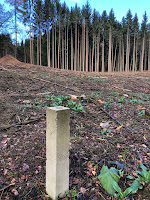 The fertile region in the southern expanse of the Rhön mountains, referred to eponymously as dig- or ditch-field is so named according to local lore that a queen once lost a beloved ring here and ordered the entire land dug up (tilled) until it was found.
The fertile region in the southern expanse of the Rhön mountains, referred to eponymously as dig- or ditch-field is so named according to local lore that a queen once lost a beloved ring here and ordered the entire land dug up (tilled) until it was found.
 In gratitude for its recovery, she founded an estate that would eventually become Königshofen, one of the major market towns dating back to the eighth century.
In gratitude for its recovery, she founded an estate that would eventually become Königshofen, one of the major market towns dating back to the eighth century.
 We took a little tour of the neighbouring counties and first made our way to Bibra, a small settlement focused and informed by the dynasty of imperial knights that governed the duchy since the tenth century and constructed this castle at the town’s centre.
We took a little tour of the neighbouring counties and first made our way to Bibra, a small settlement focused and informed by the dynasty of imperial knights that governed the duchy since the tenth century and constructed this castle at the town’s centre.
 Retaining its original style as a Franconian royal court, Burg Bibra was destroyed during the Peasants’ Revolt and rebuild in the seventeen century true to form—its most recent faithful refurbishment earning a prize in 2002 amongst castle conservators and is presently used as a seminar centre with accommodations for guests.
Retaining its original style as a Franconian royal court, Burg Bibra was destroyed during the Peasants’ Revolt and rebuild in the seventeen century true to form—its most recent faithful refurbishment earning a prize in 2002 amongst castle conservators and is presently used as a seminar centre with accommodations for guests.

 The patronage of three important prince-electors in the family brought Bibra the church of Saint Leo (dedicated to the early pontiff, Leo the Great), decorated with the altar and sculpture from the school of Tilman Riemenschneider (previously) and is one of the finest examples of late Gothic architecture.
The patronage of three important prince-electors in the family brought Bibra the church of Saint Leo (dedicated to the early pontiff, Leo the Great), decorated with the altar and sculpture from the school of Tilman Riemenschneider (previously) and is one of the finest examples of late Gothic architecture.


On the way to our next destination, we came across an open-air museum preserved in the former
expansive border-zone, demilitarised for decades but with displays of the layers of fortifications and the intervening mine field to imagine.
As with the rest of this strip of terra nullis, it is now a
nature preserve and a paradisiacal place for butterflies.

A few detours brought us to the community of Sulzdorf an der Lederhecke to see the gigantic Baroque palace Sternberg, the ancestral seat of a branch of the line of our old friends
Count Poppo and the
Hennebergs.

We marvelled at it from a distance and it was when we got a little closer, navigating the village directly behind the huge structure that we realised that we had in fact visited once before in May of 2012, noting the calendric symmetry of this construction finalised in 1669 with its four onion-domed turrets representing the seasons, twelve hearths standing for the months of the year, an astonishing and exact fifty-two doors for every week and three hundred sixty-five windows. I wonder what the story behind that decorating statement was?

The palace is privately owned still and bears some resemblance to the palace of Aschaffenburg,
Schloss Johannisburg—the residence of the archbishop of Mainz.
There were koi in the fountain and the watering trough and the Marian figure of one of the rows of homes that were at the rear of the castle was particularly striking for her iconic halo of stars.

Our final stop was a bit more secluded, though in the same community, Sulzdorf an der Lederhecke, as the last and also in private hands and occupied though by descendants of the former von Bibras. This well preserved palace on the water—
Wasserschloss—is called Burg Brennhausen and guards the frontier between Grabfeld and the
Haßbergen. The current baron is, according to the information board, a petroleum tycoon with a business in the US and divides his time between the palace and a home in Pasadena.































































